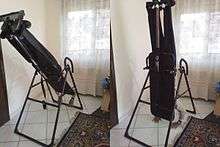Inversion therapy


Inversion therapy involves being upside down or at an inverted angle while hanging by the legs, ankles, or feet with the intention of therapeutic benefits. The process of doing so is called inversion. It is a form of spinal decompression and is a form of spinal traction.[1]
Claims
When the body's weight is suspended from the lower body the pull of gravity may decompress the joints of the body below the anchor. Hanging by the feet, as with gravity boots or inversion tables or inversion chairs, causes joints of the back to be stretched and expanded. Inversion therapy of this sort is often commercially advertised as a relief for back pain.[1] Gravity boots are the most aggressive form of the therapy and put the body completely upside down and hanging from the feet. Inversion tables are typically flat in shape and will allow the user to adjust from being upright to being horizontal and completely upside down. Tables allow for more control than boots because the user can choose a smaller angle, such as 15 degrees from horizontal, to stretch the user's back, which puts less strain on the user's feet, ankles, knees, and other joints. Inversion chairs are like tables, but they take most of the pressure off the ankles and feet. The user straps into a chair and rotates backwards to a comfortable position.
Health risks
People who have heart disease, high blood pressure, eye diseases (such as glaucoma), or are pregnant are at higher risk for the dangers related to inversion therapy and should consult their doctors about it first. The first time anyone tries inversion therapy with gravity, they should be sure to have someone standing by, in case assistance is required to get out of the apparatus, or if health problems are experienced.[1]
During an episode of acid reflux, small amounts of stomach acid manage to escape out the stomach's doorway and into the esophagus. Fortunately, gravity keeps much of the stomach acid away from this doorway. However, in an inverted position, gravity cannot do that job. Combining an inversion table and acid reflux can be a painful, nauseating, and potentially dangerous combination.[2]
See also
References
- 1 2 3 Laskowski, Edward R., M.D. (June 9, 2014). "Does inversion therapy relieve back pain? Is it safe?". Mayo Clinic. Retrieved July 11, 2015.
- ↑ Lasich, Christina, M.D. (March 7, 2011). "The Upsides and Downsides of Inversion Therapy". HealthCentral. Retrieved July 11, 2015.